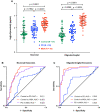α-Synuclein in blood exosomes immunoprecipitated using neuronal and oligodendroglial markers distinguishes Parkinson's disease from multiple system atrophy
- PMID: 33991233
- PMCID: PMC8357708
- DOI: 10.1007/s00401-021-02324-0
α-Synuclein in blood exosomes immunoprecipitated using neuronal and oligodendroglial markers distinguishes Parkinson's disease from multiple system atrophy
Erratum in
-
Correction to: α-Synuclein in blood exosomes immunoprecipitated using neuronal and oligodendroglial markers distinguishes Parkinson's disease from multiple system atrophy.Acta Neuropathol. 2021 Sep;142(3):513. doi: 10.1007/s00401-021-02332-0. Acta Neuropathol. 2021. PMID: 34028589 Free PMC article. No abstract available.
Abstract
The diagnosis of Parkinson's disease (PD) and atypical parkinsonian syndromes is difficult due to the lack of reliable, easily accessible biomarkers. Multiple system atrophy (MSA) is a synucleinopathy whose symptoms often overlap with PD. Exosomes isolated from blood by immunoprecipitation using CNS markers provide a window into the brain's biochemistry and may assist in distinguishing between PD and MSA. Thus, we asked whether α-synuclein (α-syn) in such exosomes could distinguish among healthy individuals, patients with PD, and patients with MSA. We isolated exosomes from the serum or plasma of these three groups by immunoprecipitation using neuronal and oligodendroglial markers in two independent cohorts and measured α-syn in these exosomes using an electrochemiluminescence ELISA. In both cohorts, α-syn concentrations were significantly lower in the control group and significantly higher in the MSA group compared to the PD group. The ratio between α-syn concentrations in putative oligodendroglial exosomes compared to putative neuronal exosomes was a particularly sensitive biomarker for distinguishing between PD and MSA. Combining this ratio with the α-syn concentration itself and the total exosome concentration, a multinomial logistic model trained on the discovery cohort separated PD from MSA with an AUC = 0.902, corresponding to 89.8% sensitivity and 86.0% specificity when applied to the independent validation cohort. The data demonstrate that a minimally invasive blood test measuring α-syn in blood exosomes immunoprecipitated using CNS markers can distinguish between patients with PD and patients with MSA with high sensitivity and specificity. Future optimization and validation of the data by other groups would allow this strategy to become a viable diagnostic test for synucleinopathies.
Keywords: Biofluid; Biomarker; Extracellular vesicles; Synucleinopathy.
© 2021. The Author(s).
Conflict of interest statement
None of the authors has any financial disclosure or conflict of interest to report.
Figures




Similar articles
-
Combining salivary α-synuclein seeding activity and miRNA-29a to distinguish Parkinson's disease and multiple system atrophy.Parkinsonism Relat Disord. 2024 Oct;127:107088. doi: 10.1016/j.parkreldis.2024.107088. Epub 2024 Aug 5. Parkinsonism Relat Disord. 2024. PMID: 39111257
-
Serum neuronal exosomes predict and differentiate Parkinson's disease from atypical parkinsonism.J Neurol Neurosurg Psychiatry. 2020 Jul;91(7):720-729. doi: 10.1136/jnnp-2019-322588. Epub 2020 Apr 9. J Neurol Neurosurg Psychiatry. 2020. PMID: 32273329 Free PMC article.
-
Distinct Autoimmune Anti-α-Synuclein Antibody Patterns in Multiple System Atrophy and Parkinson's Disease.Front Immunol. 2019 Sep 24;10:2253. doi: 10.3389/fimmu.2019.02253. eCollection 2019. Front Immunol. 2019. PMID: 31616427 Free PMC article.
-
Diagnostic utility of fluid biomarkers in multiple system atrophy: a systematic review and meta-analysis.J Neurol. 2021 Aug;268(8):2703-2712. doi: 10.1007/s00415-020-09781-9. Epub 2020 Mar 11. J Neurol. 2021. PMID: 32162061
-
The potential of phosphorylated α-synuclein as a biomarker for the diagnosis and monitoring of multiple system atrophy.CNS Neurosci Ther. 2024 Apr;30(4):e14678. doi: 10.1111/cns.14678. CNS Neurosci Ther. 2024. PMID: 38572788 Free PMC article. Review.
Cited by
-
Dual role of brain-derived extracellular vesicles in dementia-related neurodegenerative disorders: cargo of disease spreading signals and diagnostic-therapeutic molecules.Transl Neurodegener. 2022 Nov 27;11(1):50. doi: 10.1186/s40035-022-00326-w. Transl Neurodegener. 2022. PMID: 36437458 Free PMC article. Review.
-
Neuron-Derived Extracellular Vesicles: Emerging Regulators in Central Nervous System Disease Progression.Mol Neurobiol. 2025 May 6. doi: 10.1007/s12035-025-05010-4. Online ahead of print. Mol Neurobiol. 2025. PMID: 40325332 Review.
-
CNS cell-derived exosome signatures as blood-based biomarkers of neurodegenerative diseases.Front Neurosci. 2024 Jun 20;18:1426700. doi: 10.3389/fnins.2024.1426700. eCollection 2024. Front Neurosci. 2024. PMID: 38966760 Free PMC article. Review.
-
Diagnosing multiple system atrophy: current clinical guidance and emerging molecular biomarkers.Front Neurol. 2023 Sep 29;14:1210220. doi: 10.3389/fneur.2023.1210220. eCollection 2023. Front Neurol. 2023. PMID: 37840912 Free PMC article. Review.
-
Emergence of Extracellular Vesicles as "Liquid Biopsy" for Neurological Disorders: Boom or Bust.Pharmacol Rev. 2024 Feb 13;76(2):199-227. doi: 10.1124/pharmrev.122.000788. Pharmacol Rev. 2024. PMID: 38351075 Free PMC article. Review.
References
Publication types
MeSH terms
Substances
Grants and funding
- R01 NS082094/NS/NINDS NIH HHS/United States
- U54 NS065736/NS/NINDS NIH HHS/United States
- P30 AG072980/AG/NIA NIH HHS/United States
- R01 NS107596/NS/NINDS NIH HHS/United States
- P30 AG019610/AG/NIA NIH HHS/United States
- UL1 TR001881/TR/NCATS NIH HHS/United States
- K02 NS080915/NS/NINDS NIH HHS/United States
- R01 ES031106/ES/NIEHS NIH HHS/United States
- UL1 TR000124/TR/NCATS NIH HHS/United States
- R01 ES010544/ES/NIEHS NIH HHS/United States
- U24 NS072026/NS/NINDS NIH HHS/United States
- UL1 TR000040/TR/NCATS NIH HHS/United States
LinkOut - more resources
Full Text Sources
Other Literature Sources
Medical
Miscellaneous

